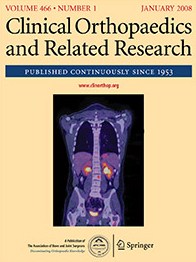
ARTHROPLASTY
MRI- and CT-templated Patient-Specific Instruments compared to conventional instruments
Clin Orthop Relat Res. 2014 Oct;472(10):2913-2290 patients diagnosed with primary osteoarthritis were randomly assigned to undergo total knee arthroplasty using either conventional instrumentation, MRI-based patient-specific instrumentation, or CT-based patient-specific instrumentation. Patients were assessed after surgery for coronal alignment (mechanical axis, femoral component, and tibial component), sagittal alignment (posterior slope), and axial alignment (rotation of the femoral component|). Clinical scores were obtained at 3 months postoperatively. Surgical duration was also documented and compared. Postoperatively, significantly fewer cases in which TKA was completed with MRI-based PSI demonstrated outliers (>3deg deviation from planned alignment) for mechanical axis, coronal alignment of the femoral component and axial alignment of the femoral component when compared to conventional instrument. CT-based PSI differed significantly compared to standard instruments only in the number of outliers in axial alignment of the femoral component. Comparisons of coronal alignment of the tibial component and posterior tibial slope did not differ significantly between any two groups.
Unlock the full ACE Report
You have access to {0} free articles per month.Click below to unlock and view this {1}
Unlock NowCritical appraisals of the latest, high-impact randomized controlled trials and systematic reviews in orthopaedics
Access to OrthoEvidence podcast content, including collaborations with the Journal of Bone and Joint Surgery, interviews with internationally recognized surgeons, and roundtable discussions on orthopaedic news and topics
Subscription to The Pulse, a twice-weekly evidence-based newsletter designed to help you make better clinical decisions
Exclusive access to original content articles, including in-house systematic reviews, and articles on health research methods and hot orthopaedic topics
Or upgrade today and gain access to all OrthoEvidence content for just $1.99 per week.
Already have an account? Log in


Subscribe to "The Pulse"
Evidence-Based Orthopaedics direct to your inbox.
{0} of {1} free articles
Become an OrthoEvidence Premium Member. Expand your perspective with high-quality evidence.
Upgrade Now












































































